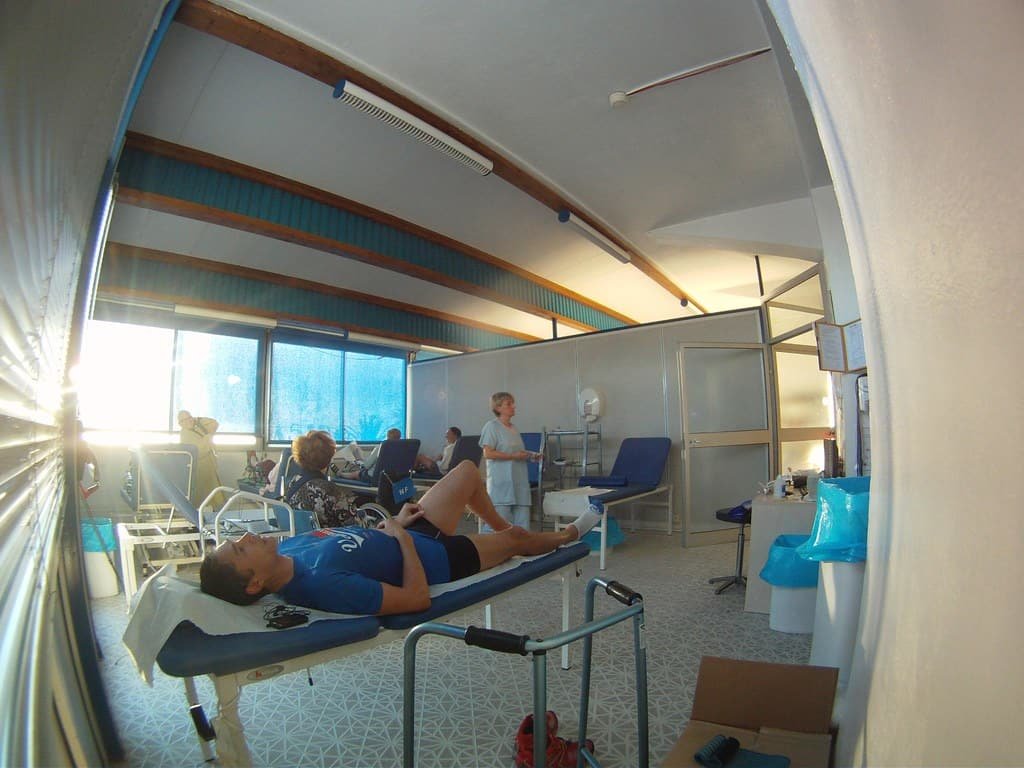Revolutionizing Rehabilitation: Why Electrotherapy is the Future of Pain Management

Wellness Fixation is reader supported, meaning I may earn a small commission if you purchase something through my links at no extra cost to you. Thanks for your support! Learn more
Revolutionizing Rehabilitation: Why Electrotherapy is the Future of Pain Management
Have you ever heard of electrotherapy? It may sound like something out of a futuristic sci-fi movie, but it’s actually a cutting-edge pain management technique that has been gaining popularity in recent years. Electrotherapy involves the use of electrical impulses to stimulate nerves and muscles, promoting healing, reducing inflammation, and relieving pain. With its non-invasive nature and numerous benefits, it’s no wonder why more people are turning to electrotherapy as a revolutionary form of rehabilitation. In this blog post, we’ll explore what electrotherapy is all about and why it could be the future of pain management. So sit back, relax (or tense up if you’re in pain!), and let’s dive into the electrifying world of electrotherapy!
What is electrotherapy?
Electrotherapy is a type of medical treatment that uses electrical impulses to stimulate nerves and muscles. It has become increasingly popular as a non-invasive method for pain management and rehabilitation. Electrotherapy can be delivered in various forms, including Transcutaneous Electrical Nerve Stimulation (TENS), Interferential Current Therapy (IFC), and Neuromuscular Electrical Stimulation (NMES).
TENS involves placing electrodes on the skin to deliver low-level electrical impulses that block pain signals from reaching the brain. IFC delivers higher-frequency electrical impulses deep into body tissues, promoting healing by increasing blood flow and reducing inflammation. NMES stimulates specific muscles with stronger electrical impulses, helping to restore function after injury or surgery.
Electrotherapy works by stimulating the body’s natural healing mechanisms through targeted electric currents. It triggers the release of endorphins, which are natural painkillers produced by the body, providing relief without relying on medication.
Electrotherapy is a safe and effective way to manage pain and promote healing for many patients suffering from chronic conditions or recovering from injuries.
How does electrotherapy work?
Electrotherapy works by using electrical impulses to stimulate nerves and muscles in the body. These electrical impulses are delivered through electrodes attached to the skin, which send small currents of electricity into the affected area.
When these electrical currents reach the nerves and muscles, they cause them to contract and relax involuntarily. This can help to improve circulation, reduce pain, increase range of motion, and promote healing.
There are several different types of electrotherapy that may be used depending on your specific condition. For example, transcutaneous electrical nerve stimulation (TENS) is a type of electrotherapy that uses low-frequency electrical pulses to alleviate pain.
Another popular form of electrotherapy is neuromuscular electrical stimulation (NMES), which uses higher frequency impulses to stimulate muscle contractions for rehabilitation purposes.
Electrotherapy has been proven effective for a wide range of conditions such as chronic pain management, post-operative recovery, sports injuries rehabilitation among others. However it’s important you receive proper medical guidance before starting any kind of treatment with this technique.
What are the benefits of electrotherapy?
Electrotherapy is a powerful tool in the field of rehabilitation and pain management. One of the biggest benefits of electrotherapy is its ability to reduce pain and inflammation. By stimulating your body’s natural healing processes, electrotherapy can help improve blood flow, reduce muscle tension, and promote tissue repair.
Another major benefit of electrotherapy is that it can be customized to suit the needs of each individual patient. With a wide range of different types and intensities available, healthcare professionals can tailor treatment plans to address specific pain points or areas of concern.
In addition to reducing pain, electrotherapy has also been shown to improve muscle strength and flexibility. This makes it an excellent choice for athletes or anyone looking to improve their physical performance.
Perhaps one of the most compelling benefits of electrotherapy is its non-invasive nature. Unlike more traditional forms of pain management like surgery or injections, there are no incisions involved with electrotherapy treatments. This means less risk for complications or side effects post-treatment.
If you’re struggling with chronic pain or injury-related discomfort, exploring the benefits offered by electrotherapy may be a good idea. Consult with your healthcare provider about whether this innovative approach might be right for you!
Are there any risks associated with electrotherapy?
While electrotherapy can provide numerous benefits, it is important to understand that there are potential risks associated with its use. One of the main risks is skin irritation or burns from the electrodes. This risk can be minimized by using proper electrode placement and adjusting the intensity level appropriately.
Another risk associated with electrotherapy is muscle soreness and fatigue after treatment. This is a normal response to any type of physical therapy, but it’s still worth noting as patients should know what to expect after their sessions.
In rare cases, some patients may experience an allergic reaction to the gel used in conjunction with the electrodes. It’s important for individuals who have sensitive skin or allergies to notify their healthcare provider before beginning electrotherapy treatment.
Additionally, individuals who have pacemakers or other implanted devices should consult with their doctor before trying electrotherapy as it could interfere with these devices’ functioning.
While there are some risks involved in electrotherapy treatment, they can be avoided by taking appropriate precautions and working closely with a trained healthcare professional throughout your rehabilitation plan.
Who can benefit from electrotherapy?
Electrotherapy is a versatile treatment option that can provide benefits to people with a wide range of conditions. One group that may particularly benefit from electrotherapy are individuals who experience chronic pain, such as those living with arthritis or fibromyalgia. Electrotherapy can help reduce pain sensations by blocking the transmission of pain signals to the brain.
Athletes and active individuals who have suffered injuries may also find relief through electrotherapy. This treatment can be used to decrease inflammation, improve circulation, and promote healing in injured tissues.
People living with neurological conditions like multiple sclerosis or Parkinson’s disease may also benefit from electrotherapy. In these cases, electrical stimulation is applied to specific areas of the body in order to improve muscle function and coordination.
Additionally, older adults who experience age-related muscle weakness or decreased mobility may find that electrotherapy helps them maintain strength and range of motion.
Anyone looking for a non-invasive treatment for pain management or rehabilitation should consider exploring their options with electrotherapy under the guidance of a healthcare professional.
How to get started with electrotherapy
Getting started with electrotherapy is a straightforward process. The first step is to consult with your doctor or physical therapist to determine if electrotherapy is right for you.
Once you have the green light, the next step is choosing the type of electrotherapy that best suits your needs. There are several options available, including TENS (transcutaneous electrical nerve stimulation) and EMS (electrical muscle stimulation).
After selecting an appropriate device or machine, it’s important to read the instructions carefully before use. Always start with a low intensity level and gradually increase as tolerated.
When applying electrodes, ensure they are placed correctly according to the manufacturer’s guidelines. A proper electrode placement will maximize effectiveness and minimize discomfort.
It’s also essential to maintain good communication with your healthcare provider throughout treatment. They can monitor progress and adjust therapy as needed.
Be consistent with your electrotherapy regimen. Consistent use can lead to better pain relief outcomes over time.
Getting started with electrotherapy involves consulting with a healthcare professional, selecting an appropriate device or machine, reading instructions carefully before use, placing electrodes correctly on target muscles areas while maintaining good communication throughout therapy sessions and being consistent in usage.
Conclusion
Electrotherapy is a safe and effective method of pain management that has revolutionized rehabilitation. With its ability to target specific areas of the body and stimulate healing processes, it has become a popular alternative to traditional pain medications.
By utilizing electrical energy to promote tissue repair, reduce inflammation, and alleviate discomfort, patients can experience relief from chronic or acute pain without relying on drugs that come with unwanted side effects.
As more research is conducted on the benefits of electrotherapy for various conditions such as arthritis or back pain, it’s clear that this innovative approach is here to stay. If you’re interested in exploring whether electrotherapy could be right for you, speak with your healthcare provider today. They can help determine if this treatment option could provide the relief you need to improve your quality of life.





